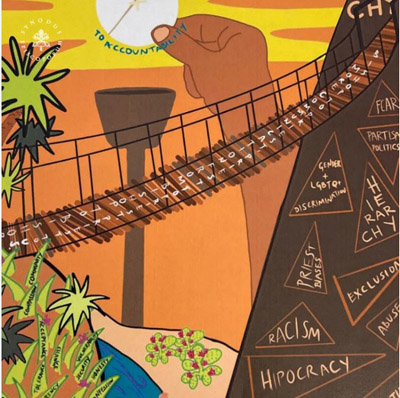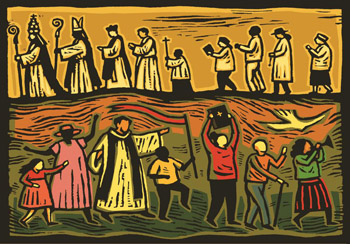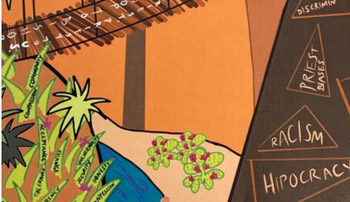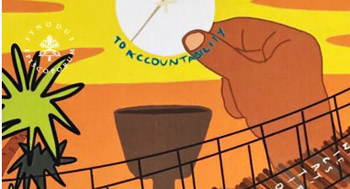Consequences of Vatican II
 |
 |
 |
 |
 |
 |
 |
The Synod’s Art – Part IV
Bridging the Gap: From a Hierarchical
to an Egalitarian Church
In our increasingly egalitarian world, almost nothing is so despised as the hierarchical structure of the Catholic Church. Because it symbolizes the antithesis of the infamous slogan of the French Revolution “Liberty, Equality, and Fraternity,” the Church’s perennial structure is now the subject of relentless criticism, coming even from priests, Prelates and the post Vatican II Popes.
In her series on the Dialogue Mass, Dr. Carol Byrne explains that it is now fashionable to denounce “clericalism,” a catch-all term that encapsulates progressivist ire toward the high dignity of the priestly office (and by extension, the higher status of the Pope and Bishops).
 Because the Synod is an attempt to democratize the Church, it is not surprising that Becky McIntyre’s art makes its own harsh censure of clericalism.
Because the Synod is an attempt to democratize the Church, it is not surprising that Becky McIntyre’s art makes its own harsh censure of clericalism.
Now that we have arrived at the fourth Synod image, I have begun to notice a trend of downward movement in them all.
The first image depicts a “deep dive” to the bottom of the ocean; the second, a journey downward to “refuge”; the third, a slide from “fragmentation” to “wholeness”; and now, the fourth, a trip down a bridge. Though this may be merely incidental, it nevertheless displays that the artist's focus is not on Heaven, but on Earth and the activities here below of mankind.
Such a shift explains the synodal disdain for hierarchy, which naturally directs itself upward, toward God. To the progressivist, expressions of inequality are reprehensible, even when they express the deference man owes to his Creator (the irreverent atmosphere of the Novus Ordo Mass demonstrates this). For those who cannot accept the superiority of God, the idea of a superior priestly class becomes particularly odious.
 Returning to the bridge, we can see that its movement is from right to left, again giving the impression of moving down from the brown dreary rock mountain to more pleasant terrain with grass and flowers: cheerful new beginning. The words, which follow this same direction, read, “More communication from bishop to bishop, bishop to priest, priest to priest, priest to us.”
Returning to the bridge, we can see that its movement is from right to left, again giving the impression of moving down from the brown dreary rock mountain to more pleasant terrain with grass and flowers: cheerful new beginning. The words, which follow this same direction, read, “More communication from bishop to bishop, bishop to priest, priest to priest, priest to us.”
This censures the respectful distance that has always defined relationships between Bishops and priests, as well as those between the clergy and laity. Of course, such relationships can be warm, but, as Bishops and priests are called to a life of greater holiness and responsibility in the Church structure, they have traditionally maintained a certain reserve.
Furthermore, before Vatican II there was never a need for lay leaders in parish councils or Vatican commissions, as it was understood that the Bishops and priests were already working for the good of the layman.
The bridge imagery in this piece implies a gradual leveling of the status of both Bishops and priests in order to bridge the gap between them and laypeople.
 On the right of the bridge, on the tall dark brown mountain, words in triangles make a slanderous depiction of the traditional Hierarchy, implying that it is constituted by “fear,” “partisan politics,” “gender and LGBTQ+ discrimination,” “priest biases,” “exclusion,” “racism,” “hypocrisy,” sexism,” “manipulation,” “judgment” and “abuse.”
On the right of the bridge, on the tall dark brown mountain, words in triangles make a slanderous depiction of the traditional Hierarchy, implying that it is constituted by “fear,” “partisan politics,” “gender and LGBTQ+ discrimination,” “priest biases,” “exclusion,” “racism,” “hypocrisy,” sexism,” “manipulation,” “judgment” and “abuse.”
These trite phrases, almost meaningless in themselves, are common leftist talking points against anything that is considered conservative. Thus, according to the Synod vantage point, the Hierarchy embodies conservatism in general, a last vestige of the West’s anti-egalitarian past. As a result, its destruction would signify the final blow to topple Western Civilization and implant a new Order, which appears to be the progressivist goal.
 In contrast to these harsh criticisms of the Hierarchy engraved on the brown mountain, the words to the left of the bridge written on green blades of grass are far more positive, making a democratic Church into a utopia of “accountability,” “honesty,” “listening,” “security,” and so on. These words speak for themselves.
In contrast to these harsh criticisms of the Hierarchy engraved on the brown mountain, the words to the left of the bridge written on green blades of grass are far more positive, making a democratic Church into a utopia of “accountability,” “honesty,” “listening,” “security,” and so on. These words speak for themselves.
The grass on the paradisiacal left side of the image represents the Synod’s intention to reconstruct the Church from the ground up, but this time as something living, green and supposedly healthful. It is not hard to figure out which side of the bridge it better, according to the Synodal Way.
According to a commentary on this piece, “Church leadership should display openness to listening and change,” including tolerance for “LGBTQ people” and “people of other faith traditions.” I am reminded of Fr. James Martin’s heretical proposition that, in order for a Catholic teaching to be binding, it has to be agreed upon by the people. In other words, in this view, laypeople must have not only representation, but also the ability to decide upon what is truth. This would be a facet of a New Synodal Church.
 Another central element in this art work is the Sacred Host in the background. As we saw in the last image, the Host seems to represent communion between members of the Church. There is nothing about it that gives us the idea it is the Body of Christ truly present in the Holy Host.
Another central element in this art work is the Sacred Host in the background. As we saw in the last image, the Host seems to represent communion between members of the Church. There is nothing about it that gives us the idea it is the Body of Christ truly present in the Holy Host.
The broken line inside it possibly suggests that the clergy, by holding to the Hierarchical Church, broke communion with the “people of God,” and must repent. The Host is elevated by an unclothed brown arm – neither black nor white, but brown, the ideal man presented by the New World Order. The bare arms suggest that the arm does not belong to a priest, who would be wearing vestments. Here is another indication of a transfer of leadership from the clergy to the laity.
The words around the Host, “Broken trust to accountability,” likely refer at least in part to the priestly abuse scandal. The scandal was indeed egregious, and must be condemned. However, there seems to be a second meaning as well: Based on the aforementioned words that call the clergy exclusive, sexist, and so on, we can see that this phrase also portrays the traditional priesthood as inherently corrupt.
For their insistence upon the past doctrine and practices of the Church, priests have "broken the trust" of the laity. It is a call to accountability to the people, a socialist message that corresponds quite well to the Socialist Church of the future.

Continued

In her series on the Dialogue Mass, Dr. Carol Byrne explains that it is now fashionable to denounce “clericalism,” a catch-all term that encapsulates progressivist ire toward the high dignity of the priestly office (and by extension, the higher status of the Pope and Bishops).

Now that we have arrived at the fourth Synod image, I have begun to notice a trend of downward movement in them all.
The first image depicts a “deep dive” to the bottom of the ocean; the second, a journey downward to “refuge”; the third, a slide from “fragmentation” to “wholeness”; and now, the fourth, a trip down a bridge. Though this may be merely incidental, it nevertheless displays that the artist's focus is not on Heaven, but on Earth and the activities here below of mankind.
Such a shift explains the synodal disdain for hierarchy, which naturally directs itself upward, toward God. To the progressivist, expressions of inequality are reprehensible, even when they express the deference man owes to his Creator (the irreverent atmosphere of the Novus Ordo Mass demonstrates this). For those who cannot accept the superiority of God, the idea of a superior priestly class becomes particularly odious.

A downward movement
This censures the respectful distance that has always defined relationships between Bishops and priests, as well as those between the clergy and laity. Of course, such relationships can be warm, but, as Bishops and priests are called to a life of greater holiness and responsibility in the Church structure, they have traditionally maintained a certain reserve.
Furthermore, before Vatican II there was never a need for lay leaders in parish councils or Vatican commissions, as it was understood that the Bishops and priests were already working for the good of the layman.
The bridge imagery in this piece implies a gradual leveling of the status of both Bishops and priests in order to bridge the gap between them and laypeople.

Out with the Church hierarchy; in with the egalitarian ‘People of God’
These trite phrases, almost meaningless in themselves, are common leftist talking points against anything that is considered conservative. Thus, according to the Synod vantage point, the Hierarchy embodies conservatism in general, a last vestige of the West’s anti-egalitarian past. As a result, its destruction would signify the final blow to topple Western Civilization and implant a new Order, which appears to be the progressivist goal.

The happy, grassy terrain of the Synodal Church...
The grass on the paradisiacal left side of the image represents the Synod’s intention to reconstruct the Church from the ground up, but this time as something living, green and supposedly healthful. It is not hard to figure out which side of the bridge it better, according to the Synodal Way.
According to a commentary on this piece, “Church leadership should display openness to listening and change,” including tolerance for “LGBTQ people” and “people of other faith traditions.” I am reminded of Fr. James Martin’s heretical proposition that, in order for a Catholic teaching to be binding, it has to be agreed upon by the people. In other words, in this view, laypeople must have not only representation, but also the ability to decide upon what is truth. This would be a facet of a New Synodal Church.

The broken line inside it possibly suggests that the clergy, by holding to the Hierarchical Church, broke communion with the “people of God,” and must repent. The Host is elevated by an unclothed brown arm – neither black nor white, but brown, the ideal man presented by the New World Order. The bare arms suggest that the arm does not belong to a priest, who would be wearing vestments. Here is another indication of a transfer of leadership from the clergy to the laity.
The words around the Host, “Broken trust to accountability,” likely refer at least in part to the priestly abuse scandal. The scandal was indeed egregious, and must be condemned. However, there seems to be a second meaning as well: Based on the aforementioned words that call the clergy exclusive, sexist, and so on, we can see that this phrase also portrays the traditional priesthood as inherently corrupt.
For their insistence upon the past doctrine and practices of the Church, priests have "broken the trust" of the laity. It is a call to accountability to the people, a socialist message that corresponds quite well to the Socialist Church of the future.

Continued

Posted February 27, 2023
______________________
______________________











